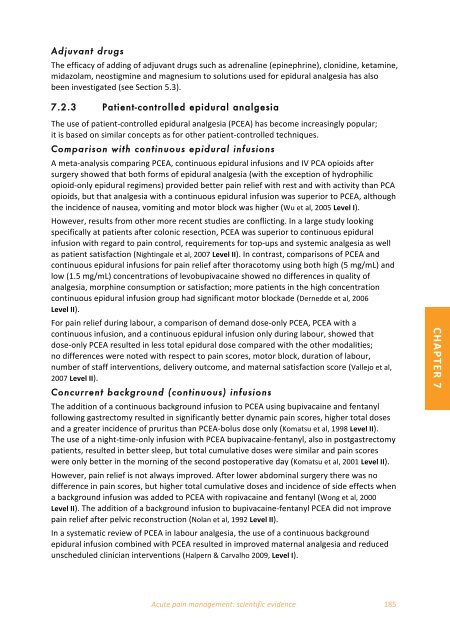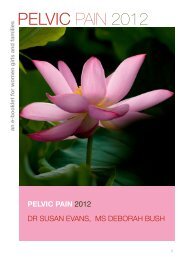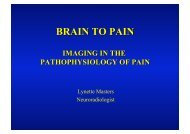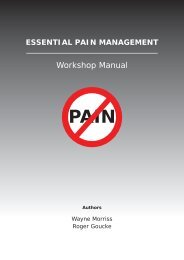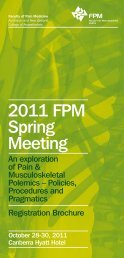Acute Pain - final version - Faculty of pain medicine - Australian and ...
Acute Pain - final version - Faculty of pain medicine - Australian and ...
Acute Pain - final version - Faculty of pain medicine - Australian and ...
Create successful ePaper yourself
Turn your PDF publications into a flip-book with our unique Google optimized e-Paper software.
<br />
<br />
Adjuvant drugs<br />
The efficacy <strong>of</strong> adding <strong>of</strong> adjuvant drugs such as adrenaline (epinephrine), clonidine, ketamine, <br />
midazolam, neostigmine <strong>and</strong> magnesium to solutions used for epidural analgesia has also <br />
been investigated (see Section 5.3). <br />
7.2.3 Patient-controlled epidural analgesia<br />
The use <strong>of</strong> patient‐controlled epidural analgesia (PCEA) has become increasingly popular; <br />
it is based on similar concepts as for other patient‐controlled techniques. <br />
Comparison with continuous epidural infusions<br />
A meta‐analysis comparing PCEA, continuous epidural infusions <strong>and</strong> IV PCA opioids after <br />
surgery showed that both forms <strong>of</strong> epidural analgesia (with the exception <strong>of</strong> hydrophilic <br />
opioid‐only epidural regimens) provided better <strong>pain</strong> relief with rest <strong>and</strong> with activity than PCA <br />
opioids, but that analgesia with a continuous epidural infusion was superior to PCEA, although <br />
the incidence <strong>of</strong> nausea, vomiting <strong>and</strong> motor block was higher (Wu et al, 2005 Level I). <br />
However, results from other more recent studies are conflicting. In a large study looking <br />
specifically at patients after colonic resection, PCEA was superior to continuous epidural <br />
infusion with regard to <strong>pain</strong> control, requirements for top‐ups <strong>and</strong> systemic analgesia as well <br />
as patient satisfaction (Nightingale et al, 2007 Level II). In contrast, comparisons <strong>of</strong> PCEA <strong>and</strong> <br />
continuous epidural infusions for <strong>pain</strong> relief after thoracotomy using both high (5 mg/mL) <strong>and</strong> <br />
low (1.5 mg/mL) concentrations <strong>of</strong> levobupivacaine showed no differences in quality <strong>of</strong> <br />
analgesia, morphine consumption or satisfaction; more patients in the high concentration <br />
continuous epidural infusion group had significant motor blockade (Dernedde et al, 2006 <br />
Level II). <br />
For <strong>pain</strong> relief during labour, a comparison <strong>of</strong> dem<strong>and</strong> dose‐only PCEA, PCEA with a <br />
continuous infusion, <strong>and</strong> a continuous epidural infusion only during labour, showed that <br />
dose‐only PCEA resulted in less total epidural dose compared with the other modalities; <br />
no differences were noted with respect to <strong>pain</strong> scores, motor block, duration <strong>of</strong> labour, <br />
number <strong>of</strong> staff interventions, delivery outcome, <strong>and</strong> maternal satisfaction score (Vallejo et al, <br />
2007 Level II). <br />
Concurrent background (continuous) infusions<br />
The addition <strong>of</strong> a continuous background infusion to PCEA using bupivacaine <strong>and</strong> fentanyl <br />
following gastrectomy resulted in significantly better dynamic <strong>pain</strong> scores, higher total doses <br />
<strong>and</strong> a greater incidence <strong>of</strong> pruritus than PCEA‐bolus dose only (Komatsu et al, 1998 Level II). <br />
The use <strong>of</strong> a night‐time‐only infusion with PCEA bupivacaine‐fentanyl, also in postgastrectomy <br />
patients, resulted in better sleep, but total cumulative doses were similar <strong>and</strong> <strong>pain</strong> scores <br />
were only better in the morning <strong>of</strong> the second postoperative day (Komatsu et al, 2001 Level II). <br />
However, <strong>pain</strong> relief is not always improved. After lower abdominal surgery there was no <br />
difference in <strong>pain</strong> scores, but higher total cumulative doses <strong>and</strong> incidence <strong>of</strong> side effects when <br />
a background infusion was added to PCEA with ropivacaine <strong>and</strong> fentanyl (Wong et al, 2000 <br />
Level II). The addition <strong>of</strong> a background infusion to bupivacaine‐fentanyl PCEA did not improve <br />
<strong>pain</strong> relief after pelvic reconstruction (Nolan et al, 1992 Level II). <br />
In a systematic review <strong>of</strong> PCEA in labour analgesia, the use <strong>of</strong> a continuous background <br />
epidural infusion combined with PCEA resulted in improved maternal analgesia <strong>and</strong> reduced <br />
unscheduled clinician interventions (Halpern & Carvalho 2009, Level I). <br />
CHAPTER 7 <br />
<strong>Acute</strong> <strong>pain</strong> management: scientific evidence 185


